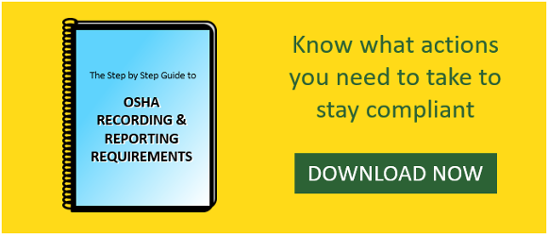Are you intimidated or confused by OSHA’s requirements for recording and reporting incidents? Maybe you just had an incident and aren’t sure what to next. First off, take a deep breath. It will be ok. This post is meant to start answering your questions about recordables and reportables. We’ll break down both and help you understand who and what is required for each.
Record keeping requirements
To help keep businesses accountable for employee safety, the Occupational Safety and Health Administration (OSHA) requires employers to keep records of their safety incidents. We often are asked the following questions regarding record keeping:
- "Who is required to keep records of safety incidents?" Any company with more than 10 employees is required to keep records of safety incidents for 5 years. An employee is defined as any person on payroll or any employee that is not on your payroll, but is being supervised day-to-day. If your business is organized as a sole proprietorship or partnership, owners and partners are not included in that count. Finally, the count is done based on peak numbers, meaning if you had more than 10 employees at any point during the previous year, you are required to record safety incidents.
- "What kind of incidents need to be recorded?" You don’t need to record every little bruise and scrape. OSHA states that if only first aid is administered, you are not required to record the incident. Incidents that will require a record are fatalities, loss of consciousness, any incident that requires days away from work, restricted work activity or job transfer, medical treatments beyond first aid, or sharps/cuts involving potentially infectious materials. You must also have annual records posted for employees to access at each of your establishments.
Reporting requirements
For serious safety incidents, OSHA requires a timely report from businesses. A quick Google search on “horrible safety incidents in history” will provide enough reason why OSHA is strict on this. The safety of employees should be top priority to each of us.
- "Who is required to report fatalities and serious injuries to OSHA?" This answer is pretty straightforward; everyone. It doesn’t matter how many employees you have or what kind of operation you run. If someone is seriously injured or dies on the job, you are required to report the incident to OSHA.
- "What kind of incidents need to be reported?" Fatalities and serious injuries must be reported. We all know what a fatality is, but what qualifies as a “serious injury”? A serious injury is defined as any injury that results in in-patient hospitalization, amputation, or eye loss. Fatalities must be reported within 8 hours of the incident, while serious injuries must be reported within 24 hours.
Looking for more information? We have a comprehensive guide to the requirements for OSHA recording and reporting. It’s a great resource to help you and your team better understand the recording and reporting process. It also contains step by step instructions for reporting incident data electronically. Get the complete guide now!
As always, safety is about more than being OSHA compliant. It’s about keeping your most valuable asset (your team) safe and healthy. At Good Day's Work, we partner with you to create a true safety culture. Let’s make sure everyone gets home safe after a good day's work.



